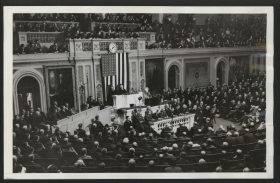Wheelchairs, Ramps, and a Scooter Named “Lulu”
In the House of Representatives, accessibility was a subject of consideration on the House Floor in the first half of the 20th century, many decades before Rep. Tony Coelho introduced the Americans with Disabilities Act in 1989. Wheelchairs, scooters, and ramps were known to be used in the Chamber and around the Capitol as early as 1881. Photographs from the House Collection document the history of accessibility in the House Chamber.
 /tiles/non-collection/7/7-27-photo-accessibility-2008_130_021_2.xml
Collection of the U.S. House of Representatives
/tiles/non-collection/7/7-27-photo-accessibility-2008_130_021_2.xml
Collection of the U.S. House of Representatives
About this object
On opening day of the 80th Congress, Representatives Joseph Mansfield, left, and Robert Crosser were seated in the aisle.
On opening day of the 80th Congress in 1947, as one photo shows, the House Chamber was packed with Members, the galleries were bustling with spectators, and
Joseph Mansfield and
Robert Crosser, two Members who used wheelchairs, faced each other on the House Floor. Mansfield, a Representative from Texas, served in Congress from 1917 to 1947. After being paralyzed in 1922, Mansfield navigated the Capitol,
House Office Buildings, and Washington, D.C., by wheelchair for 25 years. Crosser also traveled through the House by wheelchair for two decades. The House Chamber did not have special seating for Members with disabilities at the time, so Members in wheelchairs frequently sat in the wide aisles near the rostrum.
 /tiles/non-collection/7/7-27-photo-accessibility-2009_014_005.xml
Collection of the U.S. House of Representatives
/tiles/non-collection/7/7-27-photo-accessibility-2009_014_005.xml
Collection of the U.S. House of Representatives
About this object
A temporary ramp was installed in the House Chamber to assist President Roosevelt in getting to the rostrum for the 1937 Annual Message.
To address the House, Speakers and Presidents usually climbed up steps to the rostrum. However, some orators required other accommodations, even if they were kept hidden. When President Roosevelt delivered his
1935 Annual Message, the House installed a temporary ramp to assist him in getting to the rostrum, as former House Page
Glenn Rupp described. The ramp was disguised from cameras and spectators, concealed behind potted palm trees. However, for Roosevelt’s 1937 message, the palm trees were gone and the ramp was clearly visible to the cameras.
 /tiles/non-collection/7/7-27-photo-accessibility-PA2012_04_0031.xml
Collection of the U.S. House of Representatives
/tiles/non-collection/7/7-27-photo-accessibility-PA2012_04_0031.xml
Collection of the U.S. House of Representatives
About this object
In the 1950s, Representative James Auchincloss sped through the Capitol on his motorized scooter, nicknamed “Lulu.”
Although Senators were able ride a subway from their offices to the Capitol after 1909, Representatives had to walk to the Chamber for many decades longer. Realizing that his arthritis limited his ability to “hoof it” to the Capitol, in 1956, Representative
James Auchincloss acquired a three-wheeled, battery-powered scooter, which he named “Lulu.” The large scooter was the size of a riding lawnmower, and came equipped with a headlight and a roomy backseat. The
Washington Post joked that Auchincloss was “the envy of his foot-weary colleagues,” scooting around the Capitol “in his electric battery private motorcar.” Auchincloss loved to zip around the House on Lulu, and was happy to give other Members a lift. Though
Lawrence Brooks Hays enjoyed his experience thumbing a ride with Auchincloss,
Katharine St. George found the drive “very rambunctious and quite terrifying,” since it felt like traveling at “breakneck speed.” When the
Rayburn House Office Building opened in 1965, Representatives were finally able to take a subway to the Capitol.
While Auchincloss and Roosevelt figured out workarounds inside the Capitol, permanent changes were later made to the House Chamber. Voting machines were lowered and seats removed so that Members who used wheelchairs no longer sat in the aisles, as Mansfield and Crosser did in 1947. The rostrum, with its three levels and multiple stairs, was altered for accessibility in 2010. Hydraulic lifts transformed the staircases into platforms that raised and lowered from one level to the next. House Floor proceedings were now accessible by wheelchair, by foot, and even by Lulu.
Sources: The Washington Post, January 13, 1956 and August 31, 1978; Boston Globe, April 25, 2001.
This is part of a monthly series of blog posts exploring the art and history of photographs from the House Collection.



